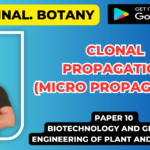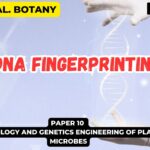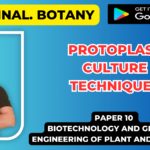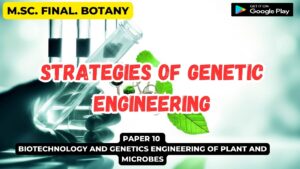![]()
Organogenesis

Organogenesis is a process of differentiation by which plant organs viz, roots, shoots, bud, flowers, stem etc. are formed while adventitious refers to the development of organs (roots, buds, shoots, flowers etc.) on embryo (embryo like structure) from unusual points of origin of an organized explant where a performed meristem is lacking.
Adventitious shoots are stem and leaf structures that arise naturally on plant tissues located in sites other than at the normal leaf axil regions.
Plant production through organogenesis can be achieved by two modes:
(i) Organogenesis through callus formation with de novo origin and
(ii) Emergence of adventitious organs directly from the explant.
1. Organogenesis by Callus Formation/Indirect Organogenesis
- Plant regeneration from cultured explant involves the initiation of callus and then shoot bud differentiation can be induced to form callus.
- However explants with mitotically active cells are good for callus initiation.
- The size and shape of the explant is also crucial.
- The increased cell number present in bigger explants increases the probability of obtaining a viable culture.
- The site of initiation of callus is generally at the peripheral surfaces of the inoculum or at the excised surface.
- It is produced on explants invitro as a result of wounding and in response to hormones, either endogenous or exogenously supplied in the medium
- Meristematic tissues should be selected in preference to other tissues because of their clonal properties, culture survival growth rates, and totipotency.
- The season of the year, donor conditions of the plant, the age and physiological state of the parent plant contribute to the success of organogenesis in cell cultures.
- Various culture media are used for organogenesis which incudes MS, B5,Whites medium (White 1963), and SH (Schenk and Hildebrandt, 1972).
- MS medium contains a high concentration of nitrogen in the form of ammonium ions unlike other media.
- Vitamins are also provided to enhance growth such as Gamborg B5 vitamins.
- Two modes of cell culture are generally used for organogenic path.
(i). Culture cell clusters on a solid medium
(ii) The culture of cell suspensions in liquid medium.
- A suspension cell culture is usually initiated by cing friable callus into liquid culture medium.
- The suspension cultures should be subcultured at least once a week while callus culture should be subcultured after 3-4 weeks.
- Growth and development of callus in culture medium depends on the composition of nutrient medium, nature of explant and environmental conditions during incubation.
- Development of callus from explant can be divided into three stages :
1. Induction
2. Cell division
3. Differentiation
- In the initial stage of induction, activity of explant increases.
- This time is the preparation time of cell division.
- The duration of induction depends on physiological state and conditions of culture.
- After this stage, rapid cell divisions take place and newly formed cells develop into callus.
- The third stage differentiation is marked by the formation of organs like roots and shoots from unorganized and undifferentiated callus.
- Growth regulator concentration in the culture medium is critical for morphogenesis.
- Auxin at a moderate to high concentration is the primary hormone used to produce callus.
- Exogenous application of auxin and cytokinin induces callus in various plant species.
- An intermediate ratio of auxin and cytokinin promotes callus induction, while a high ratio of auxin to cytokinin or cytokinin to auxin induces root and shoot regeneration respectively (Skoog and Miller, 1957).
- Only 2, 4-D is a very potent auxin used to initiate callus.
- In some species a high concentration of auxin and a low concentration of cytokinin in themedium promote abundant cell proliferation with the formation of callus.
- Cytokinins if supplied are kinetin or benzyladenine.
- Callus tissue comprises a wide range of cell types and characteristically, vacuolated cells interspersed with smaller more meristematic cells.
- Callus may serially be subcultured and grown for extended periods, but its composition and structure may change with time as certain cells are favoured by the medium and dominate the cultures.
- Under conditions favoring unorganized growth, the meristems in a callus are random and scattered.
- Transfer of callus pieces to conditions supporting organized growth leads to the formation of meristemoids also termed as growth centers.
- The meristemoids are localized clusters of cambium like cells which may become vascularized due to the appearance of trachiedal cells in the centre.
- These are the site of organ formation in the callus and can form shoots or roots.
- By varying the growth regulator levels and types, one can determine the route of morphogenesis in vitro.
- As mentioned earlier medium containing high auxin levels will induce callus formation.
- Lowering the auxin and increasing the cytokinin concentration is traditionally performed to induce shoot organogenesis from callus.
- The next phase involves the induction of roots from the shoots developed.
- IAA or IBA auxins alone or in combination with a low concentration of cytokinins are important in the induction of root primordia.
- Organogenesis can be induced from either cell suspension or callus cultures.
- One needs to transfer only cells from callus medium to regeneration medium and then continue subculturing on regeneration medium.
- Thus, organ formation is determined by quantitative interaction i.e. ratios rather than absolute concentrations of substances participating in growth and development.
2. Direct adventitious organ formation/Direct organogenesis
- The somatic tissues of higher plants are capable of regenerating adventitious plants under certain conditions.
- Adventitious buds are those which arise directly from a plant organ or a piece thereof without an intervening callus phase.
- Induction of adventitious shoots directly on roots, leaves, bulb scales and other organs of intact plants is a common method of propagation.
- In culture, this method is particularly suitable to herbaceous species.
- In Begonia for example, buds normally originate along the leaf but in a medium containing BAP, the bud formation from the cut end of the leaf is so profuse that the entire surface of the cutting becomes covered with shoot buds.
- Promotion of a bud formation by cytokinin occurs in several plant species. However, the requirement of exogenous auxin and cytokinin in the process varies with the tissue system, apparently depending on the endogenous levels of hormones in the tissue.
- These observations led to the concept of totipotency i.e. the capacity of all cells to regenerate a complete new plant even after differentiation within the somatic tissues of the plant.
- Every cell in the plant is derived from the original zygote through mitotic divisions and should contain the complete genome. Thus the formation of adventitious organs will depend on the reactivation of genes concerned with the embryonic phase of development.
- In conventional propagation, the main stimulus for adventitious shoot formation arises from the physical separation of cutting from the parent plant, causing changes in the production and distribution of endogenous hormones.
- The same applies to explants for in vitro procedures and in some species, shoot formation may occur spontaneously on a medium lacking any growth regulators. But in most species,the addition of growth regulators to the medium is required to initiate shoot formation,
- Two main types of growth regulating substances auxins and cytokinins employed at different concentrations with respect to one another depending upon the explant taken, age of the plant and growing conditions.
- Adventitious in vitro regeneration may give a much higher rate of shoot production than is possible by proliferating axillary shoots.
- Adventitious shoot proliferation is the most frequently used multiplication technique in micropropagation.













